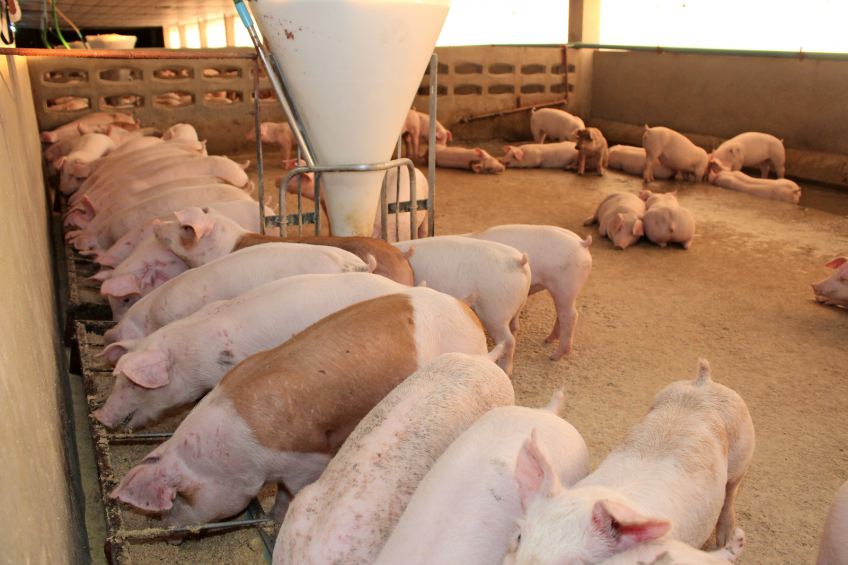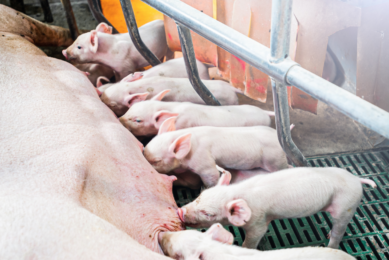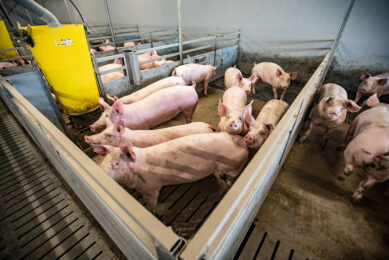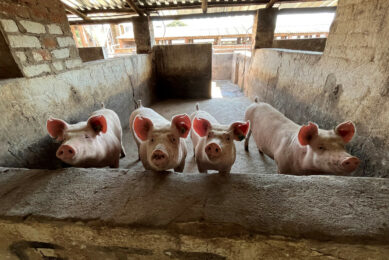Pigs tailor-made for Asia’s markets

Limpaiboon Farm in Prachinburi province, Thailand, chose not to join a big integration, but instead opted for a growing local breeding scheme. The breeding scheme SiamPigs focuses on breeding resistant, uniform animals, fit for the markets in South East Asia.
‘Independence’ was one of the key factors for Mrs Naranit Pathompothiwat, 55, when she decided to choose a different path than becoming a part of the Charoen Pokphand Foods (CPF) integration scheme. In the 1990s, she took over the farm from her parents near the city Prachinburi, Thailand. The town is located in a province with the same name, at about 170 km east of Bangkok.

Naranit (left) and Pawapat Pathompothiwat, owners of Limpaiboon Farm, Prachinburi, Thailand. Photo: Vincent ter Beek, RBI.
Mrs Naranit aimed to raise the bar. Joining the CPF would have been an obvious choice, as it is one of the world’s largest agribusiness schemes and by far Thailand’s largest pig production business. Nevertheless, she tells Pig Progress, it meant that they would have to phase out her own breeding stock, to be replaced with CPF stock.
Mrs Naranit wasn’t convinced and gradually opted for a different direction for her family business. She and her son Pawapat Pathompothiwat, 32, eventually decided to join SiamPigs, an initiative by Dr Sakchai Topanurak, lecturer at the faculty of Veterinary Science at one of Thailand’s leading universities, Chulalongkorn University in Bangkok. The concept, which was explained more in Pig Progress 32.01, is a network of pig breeders with specific breeding goals, revolving around 3 principles.
Read more about: ‘The 3 pillars of SiamPigs’.
Pigs suitable for SE Asia
The key philosophy of the principle of SiamPigs is to grow pigs which are completely suitable to South East Asian conditions. As Dr Sakchai explains, “Often pig breeds come from Europe and therefore they are fit for the European conditions. It is sometimes forgotten, however, that in Asia there are different pig diseases around – some of which don’t exist anymore in Europe.
One more reason to aim specifically for the Thai market is related to the fact that the Thai market, unlike the European market, is asking for specific traits like lean meat – leaner than in other parts of the world. In order to get most pigs as lean as desired, some producers use beta-agonists, although the usage is not permitted.”
Both problems can be solved by breeding, Dr Sakchai found, and hence the concept of SiamPigs was started. In fact, it follows the opposite philosophy of Specific Pathogen Free – it may be called Specific Pathogen Resistant. Instead of trying to keep pathogens out, these are welcomed under controlled conditions. Of course this will lead to disease and perishing of some animals, but those that remain unaffected will be used for further breeding purposes. Thus creating natural resistance against certain pathogens, like e.g. Porcine Reproductive and Respiratory Syndrome (PRRS), Actinobacillus pleuropneumoniae (App) and E. coli, a better and stronger breed can be created.
For the owners of Limpaiboon Farm, apart from independence also several other motives played a role. Being able to supply more uniform animals to the slaughterhouse, to name one, as less influence of pathogens in general leads to the outcome of there being more equally sized pigs. In addition, the scheme allows the farm to create pork that the market actually wants. Last but not least, animal welfare played a role to convert to the SiamPigs approach. Pawapat explains, “Of course I like it that the animals have a good life as long as they are with me.”
With this philosophy in the back of their minds, an own farrow-to-finish concept has been created, with currently seven locations – and counting. This consists of 3 breeding locations, surrounded by 4 grow-finisher locations, all within a 15-km radius around Prachinburi city.
Feed mill
The central farm location is a breeding site that also has a feed mill of its own, which caters for all farm sites in the surroundings. The mill, situated right at the entrance near the hygiene sluice, has a capacity of 100 tonnes per shift of eight hours, but can do up to 200 tonnes in case of a double shift. Different ground feed rations can be made; for these farms, the mill currently produces 8 different rations, based on soybeans, rice bran, premixes and sometimes probiotics.
Due to the presence of the feed mill on this farm site, roughly 100 people work on this location only, of which many live on-site. Accommodation as well as electricity is all provided by Limpaiboon Farm. When all other farm sites are taken into account, the farm employs around 200 staff.

General overview
Output of the breeding farm site is two-fold – on one hand the farm produces replacement gilts, on the other multiplication is done for commercial production. The site has a total of 24 buildings, divided as follows:
- 6 gestation houses;
- 5 farrowing barns;
- 8 weaner barns;
- 3 replacement gilt barns; and
- 2 barns for AI.
Currently, the farm weans about 26-27 piglets per sow per year and is aiming for 28.
Farrowing and gestating barns
As group housing isn’t much of an issue in Thailand, the sows are being kept in crates in the gestation rooms. In the farrowing rooms, effort is made to ensure all piglets get through the first weeks well. The piglets are being kept in specially created climatised zones, with plastic flaps so piglets can get in and out at will. While the average temperature in the tunnel-ventilated areas (with Munters equipment) is aimed at 26°C, the temperature in the climatised zones is aimed at 30°C, with help of a lamp.
Other features in the farrowing barn: the piglets are being fed additional milk feeding (Milkiwean Yoghurt; Trouw Nutrition) as well as creep feeding. In addition, the sows receive additional cooling by a dripping system which occasionally lets water fall on their heads and backs.
Interestingly, sow manure is caught in underpasses and is manually removed. The waste of the sows is entirely converted into meat as well, as the pig farm houses surround several large ponds. These are full of tilapia and pangasius fish, which thrive on pig effluent. The slurry from the weaner and finisher houses is automatically removed by a slope and flushed out every day, through a pipe into the ponds. The slurry from the sow houses is manually transported to the ponds. Every six to seven months, the water of the ponds is gradually reduced and the fish are all collected in a corner, after which the animals are harvested.
Replacement gilts
All piglets are weaned at about 23-25 days (6.5 to 7.3 kg). Those animals which are selected to become replacement gilts will stay on this site, first in weaner facilites, later in replacement gilt barns with tunnel ventilation.
The younger groups still consist of both males and gilts. Some of the males are left intact and removed from these groups to become breeding boars at a later stage. At their third oestrus they are taken away for their first round of insemination.

By this time the gilts get nearer to their first insemination, their meaty shape becomes very striking, as they have developed round, powerful hind legs, and their large size hams is accentuated by a nice line running all over their backs.
Worth mentioning: in each pen, there is a water basin which serves as a deposition of manure. It does, however, also attract the pigs as it is nice and cool to rest there.
Grow-finishers
The animals bred for commercial production leave the central facility of Limpaiboon Farm after weaning, to be transported to a grow-finisher facility in the neighbourhood, roughly 5 km down the road. The setup of these buildings is much like those of the replacement gilts. Again, they are located adjacent to several large ponds and once more, tunnel ventilation is applied. The growers are usually around 100 in one pen. At a certain moment, a selection is removed for external sale, after which around 60 per pen remain for finishing on their own farm.
The finisher pigs from Limpaiboon are usually sent to slaughter at 115 kg. In 2015 on average the farm made a good profit of over 10 baht (roughly € 0.25) per kg meat sold. This is about 2-3 baht more than a farm would get with ‘conventional’ pigs. Partly this is due to the focus on breeding more lean meat, but also the Feed Conversion Rate (FCR) in the nursery (1.3 to 1.4), overall FCR (2.2 to 2.3) and overall Average Daily Gain (770-780 g) play a role. The resistance to certain diseases definitely plays a part in this, says Dr Sakchai.
General health status
Even stronger, it goes beyond the diseases mentioned. As basic pathogens don’t cause disease, the general health status of a farm is better. Pawapat and his mother are convinced that co-infections do not affect the farm as much. Pawapat tells, “At a recent meeting in Hua Hin, Thailand, the pig farmers present were asked how many of us had escaped highly pathogenic PRRS outbreaks. We raised our hands – there was only one other farm owner in the entire room who also did so. The other people just couldn’t believe it!”
This article was published in Pig Progress 2016 nr 5, to read more articles from this issue see our digital magazine section.















